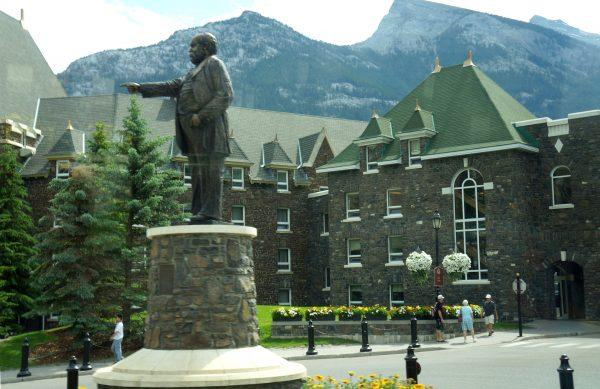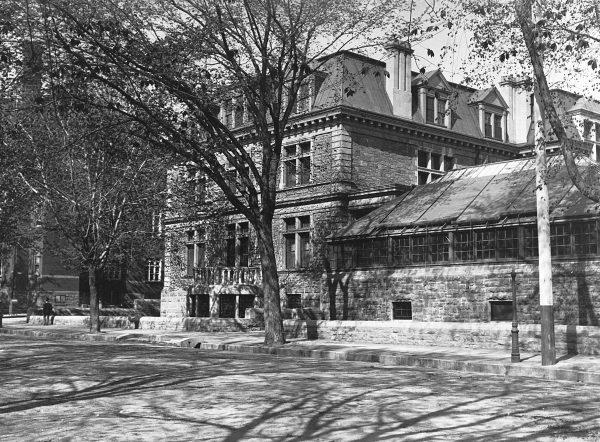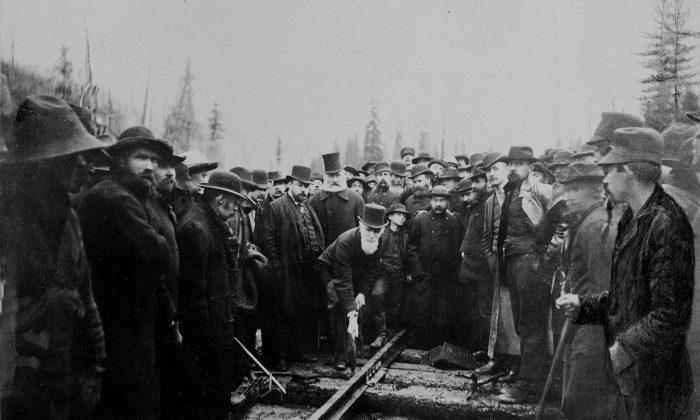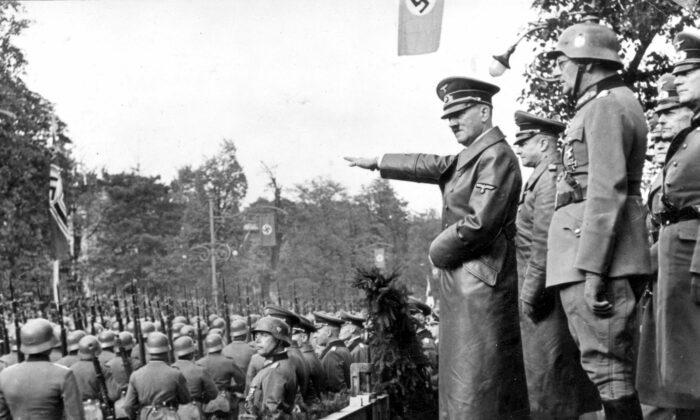It is the story of the Canadian Pacific Railway (CPR), which melded the country together from coast to coast, and of the towering figure of William Cornelius Van Horne, who simultaneously pulled off the spectacular feat of railway construction and nation building.
If the British North American Act signed on July 1, 1867, represented Canada’s birthday, Nov. 7, 1885, marked its coming of age, with a simple ceremony that set in place the last building block of the nation.
On that day, Donald Smith (later Lord Strathcona), one of the financiers of the monumental CPR project, symbolically drove an iron spike into the ground. The assembled crowd of dignitaries and ordinary folk erupted into cheers.
The ceremony, held in Craigellachie, B.C., marked the completion of the railway, the steel backbone of a country that was to become the second biggest in the world, a land of immense opportunity, and a magnet for immigrants and tourists from all over the globe.
The hero of the hour was William Cornelius Van Horne.
“All I can say is that the work has been done well in every way”—this was all he managed to say in response to calls for a speech.
It was a masterpiece of understatement. But then, Van Horne was a man of vision and action rather than an orator.
As general manager and then president of the CPR, he managed the incredible feat of laying 3,800 kilometres of track through some of the most difficult terrain in the world in five years—less than half the time envisioned by Prime Minister Sir. John A. Macdonald.
Pivotal Role
Ottawa writer and historian Valerie Knowles says there was a lack of due recognition for the larger-than-life railway baron. She set out to make Canadians more aware of the pivotal role that Van Horne played in our nation’s history.“The idea for a book originated years ago with my husband David’s observation that no full-length biography of Sir William had been published since 1920,” said Knowles in an interview.
Knowles, who grew up in Montreal—Van Horne’s home base and the headquarters of the CPR—was also inspired by longstanding questions she had entertained about Van Horne. She remembers walking past the Van Horne family home on Sherbrooke Street as a young woman.
“One of my questions was about the magnificent art collection he had assembled there,” said Knowles, whose great grandfather, Sen. Robin Mackay, was a friend of Van Horne.
Knowles laboured on and off for 12 years. The result was her 2004 book, “From Telegrapher to Titan: The Life of William C. Van Horne,” published by Dundurn Press.
A well-rounded portrait of Van Horne and his times, both this book and a shorter version published in 2010 give a fascinating view of a multi-talented dynamo of a man. As Knowles points out, Van Horne’s contributions far exceeded the building of a railway line, as significant as this was to the history of the country.
An artist of some merit himself, Van Horne patronized Canadian artists when Canadian culture was still in an embryonic stage and their works were considered inferior to those of European painters. Van Horne invited some Canadian artists to travel for free on the CPR in return for producing paintings of the stunning landscapes en route. These, in turn, lured thousands of tourists to travel by train to see the spectacular beauty of the country for themselves.
As he famously said, “If we can’t bring the mountains to the tourists, we will bring the tourists to the mountains.”
Van Horne also directed and, in some cases, designed the building of hotels, such as the Chateau Frontenac in Quebec City and the Banff Springs Hotel in Alberta, which added to the coffers of the CPR and are still admired as historic landmarks.
He contributed to the developing country’s economy in other ways as well. His marketing strategies for the railway company lured not only tourists but also thousands of immigrants to the golden opportunities that life in Western Canada promised.
“Van Horne also invested in Canadian companies, among others, the Windsor Salt Company and the Laurentide Pulp Company,” Knowles said.
But his signature achievement, the building of the CPR, reads like an epic tale of drama and adventure.

A Quintessentially Canadian Dream
When Van Horne (who was born in the United States and developed his early railway career there) was appointed general manager of the CPR in 1882, the fate of Canada was hanging in the balance and literally depended on the completion of the transcontinental railroad. The British North America Act, signed on July 1, 1867, had incorporated the railway into the nation’s constitution. British Columbia agreed to join the confederation only on the condition that the railway reached across the province.By 1878, British Columbia was threatening to secede if its terms were not met. By rising to the challenge, Van Horne changed the course of Canadian history.
Knowles’s books weave a colourful tale of the fulfillment of a quintessentially Canadian dream.
A high school drop-out in Joliet, Illinois—where his father was once the town mayor but left the family impoverished when he died—Van Horne took a job at age 14 as a telegraph operator with the Illinois Central Railroad Company. A series of increasingly responsible jobs with railway companies gave him the opportunity to master all aspects of railway construction and management.
The offer from Canada’s CPR proved to be the turning point in his career, a golden opportunity that he seized and which led to the peaks of success and the lavish lifestyle that he had craved as a boy.
Once he moved his family to Canada, first to Winnipeg and then to Montreal, Van Horne became as loyal to this country as any United Empire Loyalist, accepting a knighthood from Queen Victoria in 1894 after the completion of the railway and becoming a naturalized citizen in 1914.
When he died at the age of 72 on Sept. 11, 1915, flags on CPR buildings bowed at half-mast and church bells tolled across the country. The funeral procession departed by train from Montreal, carrying his body to Joliet to be buried at Oakwood Cemetery where other members of his family were buried.
In 1973, Van Horne’s mansion on Sherbrooke St. in Montreal was demolished despite the protests of heritage conservationists. But Covenhoven, his summer home in New Brunswick, has been designated a National Historic Site of Canada.
Fittingly, a bronze statue of the railway titan stands on guard beside the Banff Springs Hotel.







Friends Read Free